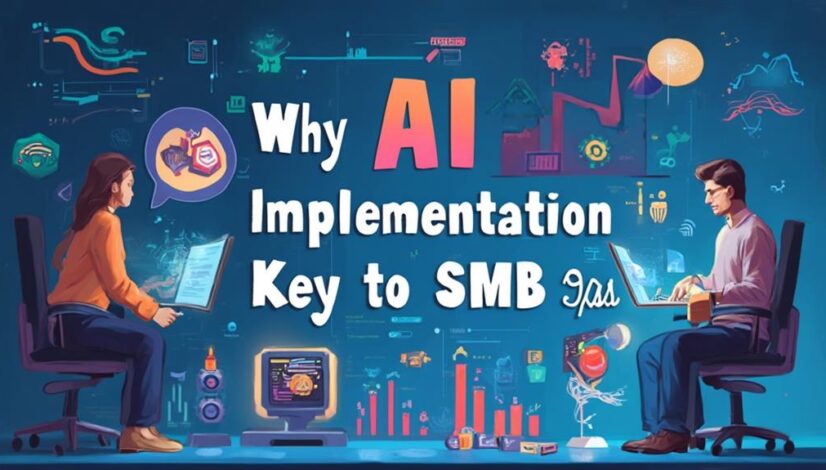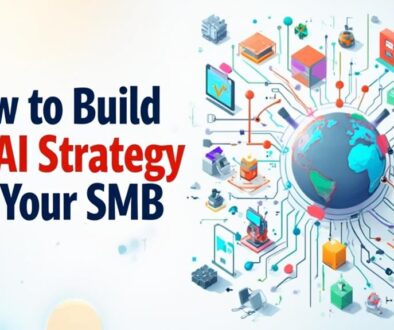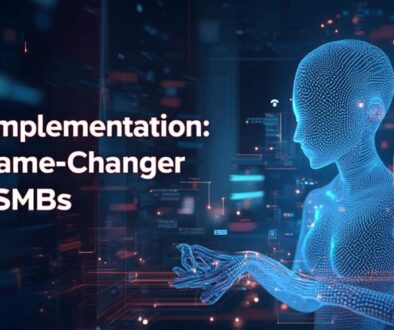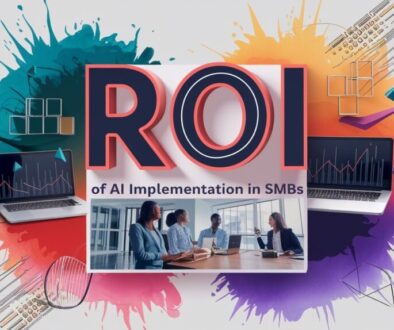Why AI Implementation Is the Key to SMB Success
AI implementation is pivotal for small and medium-sized businesses (SMBs) as it enhances operational efficiency and drives data-informed decision-making. By automating processes, AI reduces costs and identifies inefficiencies, allowing SMBs to allocate resources effectively. Additionally, predictive analytics enables businesses to anticipate trends and customer needs, fostering personalized experiences and deeper customer engagement. Embracing AI cultivates a culture of innovation and continuous improvement, providing a strategic edge in competitive markets. As SMBs navigate the complexities of digital transformation, understanding the nuanced benefits of AI can release greater potential for sustainable growth and market relevance.
Key Takeaways
- AI enhances operational efficiency by automating processes, leading to cost reductions and optimized workflows for SMBs.
- Data-driven decision-making is bolstered by AI, providing actionable insights that promote strategic growth and competitive advantage.
- Integration of AI tools allows for better resource allocation and anticipates future market trends, enhancing agility and responsiveness.
- Personalized customer experiences through AI improve engagement and satisfaction, driving loyalty and repeat business for SMBs.
- Ongoing employee training ensures effective adoption of AI technologies, fostering a culture of continuous improvement and innovation.
Understanding AI and SMBs

Understanding the role of artificial intelligence (AI) in the landscape of small and medium-sized businesses (SMBs) is essential for strategic growth in today's competitive market. AI Basics encompass a broad range of technologies, which can greatly mitigate SMB challenges such as limited resources and market access.
When contemplating implementation strategies, businesses must assess the relevance of various AI tools tailored to their industry applications, enabling them to remain agile and responsive.
However, adoption barriers persist, particularly the perceived complexity of AI solutions and the lack of expertise among current staff. Addressing these challenges requires a proactive approach to skill development, ensuring that employees can leverage AI effectively to facilitate decision-making processes.
Beyond technical hurdles, risk management and ethical considerations are paramount. SMBs must navigate the implications of data privacy and algorithmic bias to maintain consumer trust and adhere to regulatory standards.
Success stories from industry pioneers illustrate the transformative potential of AI when aligned with business objectives. These examples provide invaluable insights into the practical steps needed to harness AI's capabilities, highlighting the importance of a robust strategic framework that emphasizes continuous learning and adaptation.
The journey toward AI integration is not without its hurdles, but a clear focus on understanding its role can reveal substantial opportunities for growth, innovation, and competitive advantage in the SMB sector.
Benefits of AI Integration
The integration of AI within small and medium-sized businesses presents significant advantages, particularly in enhancing operational efficiency and streamlining processes.
By leveraging advanced analytics, organizations can make data-driven decisions that not only improve strategic outcomes but also uncover cost reduction opportunities.
This strategic alignment drives competitive advantage and fosters sustainable growth in an increasingly dynamic marketplace.
Enhanced Operational Efficiency
Implementing AI solutions is revolutionizing operational efficiency for small and medium-sized businesses (SMBs), enabling them to streamline processes, reduce costs, and enhance productivity. By integrating automation tools, SMBs can achieve significant workflow optimization, allowing routine tasks to be completed faster and with greater accuracy. This shift leads to notable productivity gains, as employees can focus on higher-value activities instead of mundane operational duties.
Through effective task management supported by AI, businesses can improve resource allocation. The intelligent deployment of resources not only addresses current needs but also anticipates future demands, enabling a more strategic approach to growth.
Furthermore, process improvement becomes more achievable, as AI systems analyze workflows, identifying bottlenecks and suggesting enhancements.
The journey towards enhanced operational efficiency demands a robust commitment to technology adoption and employee training. Organizations must equip their workforce with the skills necessary to leverage AI capabilities effectively.
By fostering an environment that embraces innovation, SMBs position themselves to thrive in an increasingly competitive landscape, achieving sustained operational excellence while retaining the freedom to explore new market opportunities.
Consequently, investing in AI is not just a trend; it's a strategic imperative for success.
Data-Driven Decision Making
Harnessing the power of AI for data-driven decision making enables SMBs to transform vast amounts of information into actionable insights. The integration of advanced data analysis techniques allows organizations to sift through complex datasets, revealing patterns that might otherwise remain obscured. This capability is essential for crafting strategies that resonate with market demands and customer preferences.
Moreover, predictive modeling serves as a significant asset in this scenario. By utilizing historical data to forecast future trends, SMBs can proactively adapt their business models, ensuring they remain competitive. Such models facilitate scenario planning, empowering organizations to assess the potential impact of various decisions before implementation. This strategic foresight not only mitigates risks but also fosters a culture of agility and innovation.
The combination of data analysis and predictive modeling further enhances operational transparency, enabling decision-makers to argue their choices with empirical evidence. As SMBs cultivate a data-driven culture, they promote autonomy among employees, encouraging them to engage in informed decision-making processes.
Ultimately, the effective use of AI in these areas positions SMBs for sustained growth and resilience in an increasingly dynamic marketplace.
Cost Reduction Opportunities
As SMBs embrace data-driven decision-making, they simultaneously open avenues for significant cost reduction through AI integration. The deployment of automation tools enables businesses to streamline repetitive tasks, reducing labor costs and minimizing human error. This efficiency fosters enhanced operational agility, allowing companies to respond swiftly to market changes while freeing resources for strategic initiatives.
Additionally, predictive analytics plays a pivotal role in advanced cost analysis. By analyzing historical data, SMBs can forecast expenditures more accurately, facilitating smarter resource allocation. This insight empowers leaders to identify inefficiencies and optimize workforce utilization, ensuring that each employee's skills are aligned with business needs.
Technology investment in AI not only enhances financial forecasting but also creates a culture of continuous improvement. By leveraging these insights, SMBs can make informed decisions that prioritize cost savings while maintaining service quality.
Moreover, the scalability of AI solutions permits businesses to adapt their strategies dynamically, aligning growth aspirations with cost control.
Streamlining Operations With AI

In the swiftly changing landscape of small and medium-sized businesses (SMBs), operational efficiency has become a critical factor for success. To achieve this, integrating AI tools into daily operations is no longer an optional enhancement—it's a strategic necessity. By leveraging workflow automation, SMBs can streamline repetitive tasks, effectively freeing up valuable time for employees to focus on their core responsibilities.
Predictive analytics serves as a powerful mechanism for operational scalability, enabling businesses to anticipate market trends and adjust their strategies accordingly. This foresight aids in resource management, allowing SMBs to allocate their assets intelligently, minimizing waste, and enhancing overall productivity.
Furthermore, process optimization becomes attainable as AI tools analyze data to identify bottlenecks and suggest improvements, ensuring that operations run smoothly. Task prioritization can also benefit considerably from AI implementation. Intelligent algorithms can assess urgency and importance, providing teams with actionable insights that enhance workflow continuity.
As SMBs adopt these technologies, employee training plays a pivotal role in ensuring that staff are equipped to harness the benefits of AI effectively. Successful technology adoption doesn't end with implementation; it requires ongoing system integration to adapt to evolving business needs.
As SMBs embrace these innovations, they position themselves not just for immediate efficiency gains, but for long-term sustainability and growth in an increasingly competitive marketplace.
Enhancing Customer Experience
To thrive in an increasingly competitive marketplace, enhancing customer experience has emerged as a crucial strategic priority for SMBs. Organizations can harness artificial intelligence to deliver personalized interactions that resonate with each individual customer. By leveraging automated responses, businesses can provide immediate assistance, thereby dramatically improving user experience and fostering a sense of accessibility.
Furthermore, actively soliciting and analyzing customer feedback enables SMBs to refine engagement strategies. AI tools, particularly predictive analytics, empower businesses to anticipate customer needs and preferences, ensuring that products and services are tailored to meet their expectations. Implementing such insights can greatly increase satisfaction and loyalty.
Effective loyalty programs, driven by AI, allow for service customization that aligns with the unique characteristics of each customer segment. These initiatives not only encourage repeat purchases but also deepen the emotional connection between the brand and its customers. By employing sophisticated algorithms that evaluate purchase history and interaction patterns, SMBs can craft offers that truly resonate with their clients.
Moreover, in the area of user experience, AI facilitates a seamless transaction process, minimizing friction points and enabling customers to navigate services effortlessly. As these technologies evolve, they will certainly enhance the quality of customer interactions, establishing strong, lasting relationships.
Ultimately, by prioritizing the enhancement of customer experience through AI, SMBs can differentiate themselves in the marketplace, cultivate customer loyalty, and drive sustainable growth. Embracing this technological advancement will empower organizations to meet and exceed the expectations of their clientele effectively.
Data-Driven Decision Making

In today's competitive landscape, data-driven decision making emerges as a critical pillar for SMB success, offering improved insights and analytics that drive strategic initiatives.
By leveraging advanced AI tools, organizations can gain a deeper understanding of their operations, leading to enhanced operational efficiency and more informed resource allocation.
Ultimately, embracing a data-centric approach empowers SMBs to identify opportunities for growth and streamline processes, ensuring long-term sustainability.
Improved Insights and Analytics
Harnessing the power of data through AI-driven insights and analytics has become a pivotal strategy for small and medium-sized businesses (SMBs) aiming to enhance decision-making processes. By implementing predictive analytics, SMBs can anticipate customer needs and market trends, allowing for timely strategic adjustments.
Customer segmentation, enabled by behavior analysis, offers a nuanced understanding of diverse consumer groups, empowering SMBs to tailor their offerings effectively.
Data visualization simplifies the complexity of data interpretation, transforming extensive datasets into accessible, actionable insights. This not only enhances communication among stakeholders but also facilitates swift decision-making.
Trend analysis is essential for identifying industry shifts, which enhances market forecasting accuracy. Coupled with robust performance metrics, it provides SMBs with a thorough view of operational success and areas requiring improvement.
In addition, effective risk assessment, grounded in data-driven insights, mitigates decision-making uncertainties, allowing businesses to navigate potential challenges proactively.
Enhanced Operational Efficiency
The insights gained from improved analytics lay the groundwork for enhanced operational efficiency within SMBs. By harnessing data-driven decision-making, businesses can identify inefficiencies and areas ripe for improvement.
Implementing process automation tools is essential; they allow SMBs to streamline repetitive tasks, freeing up valuable human resources for strategic initiatives. This shift not only drives productivity but also fosters innovation by enabling teams to focus on complex problem-solving rather than mundane activities.
Furthermore, workflow optimization enhances communication and collaboration among team members. By utilizing AI-powered platforms, SMBs can create seamless workflows that minimize bottlenecks and elevate overall performance.
The integration of real-time data into day-to-day operations enables quicker feedback loops, leading to agile responses to market changes.
Ultimately, by leveraging these technological advancements, SMBs can achieve a significant competitive edge. Enhanced operational efficiency not only improves internal capabilities but also elevates customer service, as businesses become more responsive and adaptive to client needs.
In this landscape, data is not merely a byproduct but an invaluable asset driving success and operational excellence. Embracing AI tools facilitates this transformation, promoting a culture of continuous improvement and empowering SMBs to thrive in an ever-evolving marketplace.
Future Trends in AI for SMBs
As small and medium-sized businesses (SMBs) navigate an increasingly competitive landscape, three key trends in artificial intelligence (AI) are poised to greatly influence their operational strategies.
First, the ethical considerations surrounding AI implementation are becoming paramount. SMBs must prioritize transparency and fairness, guaranteeing that their AI practices do not inadvertently perpetuate bias, which could harm their business reputation and customer trust.
Second, AI accessibility continues to broaden. The evolution of user-friendly tools and platforms empowers smaller organizations to leverage advanced technologies without the need for extensive resources. This democratization of AI fosters a future workforce that is more digitally literate, enabling employees at all levels to harness AI's potential effectively.
However, integrating these systems is not without its challenges. Businesses must invest in thorough training programs to overcome integration challenges and guarantee AI literacy within their teams.
Lastly, as regulatory frameworks evolve, SMBs must remain attuned to compliance requirements while exploring industry-specific applications. This alignment can yield significant competitive advantages, allowing SMBs to innovate strategically and forge impactful technology partnerships.
Frequently Asked Questions
What Initial Costs Are Associated With AI Implementation for Smbs?
The initial costs associated with AI implementation for small and medium businesses (SMBs) include technology acquisition, software licensing, and potential infrastructure upgrades.
Furthermore, organizations must consider the initial investment in staff training and change management to effectively integrate AI systems.
Beyond the implementation phase, ongoing maintenance expenses can arise from software updates, system monitoring, and support services.
A strategic approach to budgeting for these costs is essential for sustainable AI integration and long-term success.
How Can SMBS Choose the Right AI Tools for Their Needs?
Maneuvering the vast landscape of AI tool selection can feel like finding a needle in a haystack.
To choose the right AI tools for their needs, SMBs must first analyze their specific requirements, including objectives, budget constraints, and scalability. Engaging with stakeholders to gather insights can illuminate real-world pain points.
In addition, evaluating potential tools based on functionality, user experience, and compatibility with existing systems will substantiate a strategic decision that aligns with long-term goals.
Is AI Integration Suitable for All Types of Smbs?
AI integration may not be universally suitable for all types of small and medium-sized businesses (SMBs).
Its effectiveness largely depends on industry-specific applications and the unique operational needs of each enterprise.
Businesses in data-intensive sectors, such as finance or healthcare, might find more immediate benefits compared to those in less data-driven industries.
Therefore, a strategic assessment of AI suitability is imperative for each SMB to guarantee alignment with their objectives and capabilities.
What Common Challenges Do SMBS Face During AI Adoption?
Small and medium-sized businesses (SMBs) often face several hurdles during AI adoption.
Key challenges include ensuring data privacy while integrating new technologies, necessitating extensive employee training to foster skill development.
Moreover, effective change management is critical to minimize resistance.
Issues of infrastructure readiness complicate integration, alongside scalability concerns that may deter growth.
Additionally, budget constraints frequently limit the capacity to invest in necessary tools, thereby hindering successful implementation.
How Long Does It Typically Take to See AI Benefits?
The AI timeline for realizing benefits can vary considerably across organizations, akin to waiting for a garden to flourish after planting seeds.
Typically, measurable benefits materialize within six to twelve months, contingent upon factors such as integration complexity and resource allocation.
Effective benefit measurement involves continuous assessment of key performance indicators, allowing teams to fine-tune strategies.
Understanding this timeline empowers organizations to manage expectations and optimize the deployment for maximum impact.
Conclusion
The integration of artificial intelligence within small and medium-sized businesses represents a pivotal opportunity for success in a competitive landscape. By harnessing the power of AI, operations can be streamlined, customer experiences can be enhanced, and data-driven decision-making can flourish. As the adage goes, "A stitch in time saves nine"; proactive implementation of AI technologies will not only address immediate operational challenges but also lay the groundwork for sustainable growth and innovation in an evolving market.




